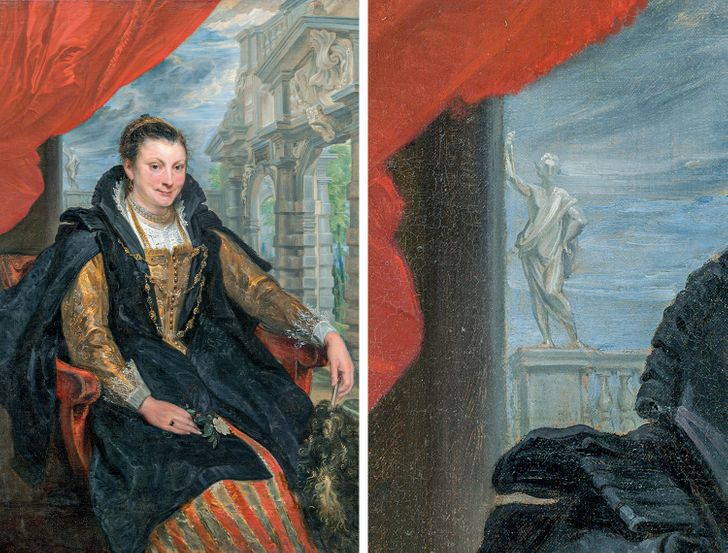He put a ring on her right hand on her ring finger!
9 Hidden Details in Famous Paintings That Not Every Art Expert Knows About

Many masterpieces of art hide mysterious stories. No matter how thoroughly researchers study paintings, there’s always some other important detail they find that can change the meaning of the entire painting.
We at Bright Side got ourselves a magnifying glass and several encyclopedias on art to take a different look at the paintings by famous artists.
The 17th-century love triangle
The classic 17th-century portrait hides an interesting love story — this is the conclusion Cambridge scientists made after they analyzed the portrait of Isabella Brant by Anthony van Dyck. The artist decided to paint a portrait of his mentor’s wife as a gift but other researchers think that Rubens, who was the mentor, never got the painting because van Dyck kept it.
The mysterious figure in the background is a hint that Isabella Brant and Anthony Van Dyck had a love affair. So, this detail shows that she probably had a lover. Besides, the position of Isabella to the left of the viewer is against the tradition because this was the position for the husband, not the wife. Van Dyck might have tried to symbolically destroy Rubens’ marriage.
Monkey as a personality symbol
Frida Kahlo often drew small monkeys next to her. And there was a reason: the artist tried to highlight the power and her passion for Mexican history and culture. The thing is, in the Aztec culture, monkeys were a symbol of fertility, famous for their insolence, and love for dancing and art.
Ghosts on the paintings by Modigliani
The portrait of the mysterious Antonia created by Amedeo Modigliani attracts our attention not only because it’s so dark. Researchers found that there are pictures of human faces hidden in unexpected places.
In infrared light, you can count at least 4 “ghosts.” Most likely, Modigliani used the canvas several times.
“Identical” soup cans
Campbell’s Soup Cans is one of the most famous works by Andy Warhol, where the idea is repeating the same image over and over again. Warhol made it un-original on purpose. His painting is mimicking the uniformed and repetitive form of most famous commercials.
Even though the soup cans seem identical, the artist still added some differences. If you look close, you will see the sticker designs might be different on different cans. So, his individual style is still there in the painting.
2 pantings in 1
X-raying paintings sometimes leads to very unexpected discoveries. For example, in this painting of grass by Vincent van Gogh, there is actually a portrait of a peasant.
The secret of this painting is that the artist often painted over his earlier works. According to experts, around 1/3 of his early works were painted over.
Faded portrait
Renoir was so happy with his portrait of Madame Léon Clapisson that he chose it to be exhibited in 1883. And only later, when researchers decided to remove the frame, did they see that the part of the canvas hidden behind the frame had different colors.
This difference in colors gave birth to the theory that the calm colors on the painting were actually bright when Renoir originally used them. They had just faded over time.
Monet’s hidden jars
Wisteria by Claude Monet is probably the last secret of the great artist. When restorers were preparing the painting for an exhibition, they found some strokes on the painting they thought Monet made to cover something. So they X-rayed the painting.
It turned out that there was another painting under Wisteria that showed the water lilies that made him quite popular in the past.
Invisible ink
One of Jean-Michel Basquiat’s paintings called Untitled (1981)
American artist Jean-Michel Basquiat often experimented with his paintings and left a lot of secret details on the canvas. So, during another authenticity test, art experts found invisible ink on the painting that recreated the entire look of the painting.
Now, experts recommend for other owners of Basquiat’s paintings to scan them and find other hidden details.
A jar as Henri Matisse’s main model
This jar is Henri Matisse’s main star. The thing is, he used the same things when working on his paintings. So, the jar that first appeared in his paintings in 1917 was later found in his 1930s works.
How important do you think it is to discover secret signs in paintings? Do they change the point of the painting or do they just switch the focus to some unimportant details?
Comments
Related Reads
9 Tricks to Find Out If Someone Is Telling the Truth

15+ Actors Whose Improvisation Made It Into the Final Version

Fans Suspect Johnny Depp, 60, and Jenna Ortega, 20, Are Dating and the Stars Respond to the Rumors

I Refuse to Sacrifice My Social Life Just Because My Wife Is Tired of Being a Mom

22 People Who Found a Hidden Treasure Where They Least Expected It

15 Moments That Prove Quiet Kindness Still Holds the World Together

10 Honest Stories That Capture the Struggles and Pain of Blended Families

15+ Heartfelt Times When Women Proved There’s a Rainbow After Every Storm

I Refuse to Give My Son His Father’s Inheritance—He Needs to Be on His Own Now

I Refuse to Keep Supporting My Daughter and Her 5 Kids for Free

I Refused to Help My Sister Save Her Dying Kid, My Money Isn’t a Family Tradition

I Refused to Take My Stepdaughter on Our Family Trip









